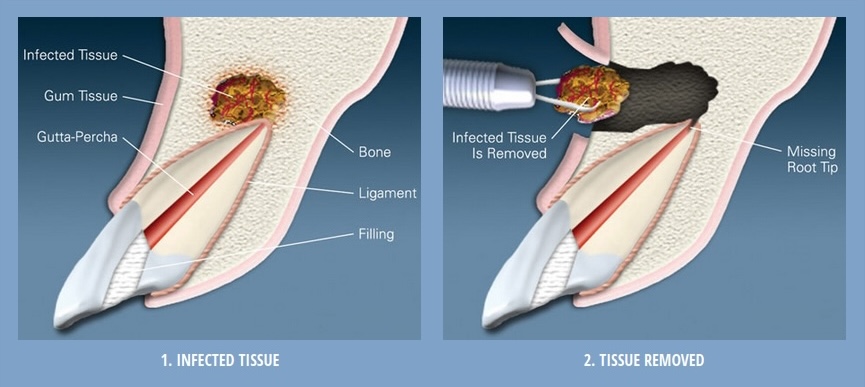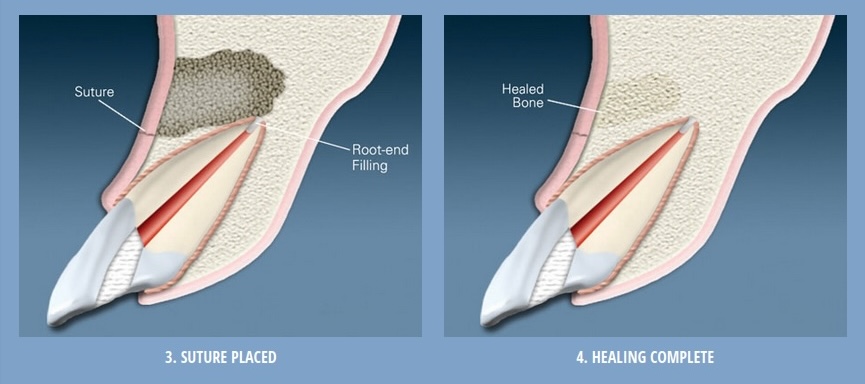Procedures
Root Canal Treatment
What is a root canal?
A root canal is a valuable dental procedure used to treat and preserve natural teeth with inflamed or infected roots. The pulp is the tissue within the center of the tooth that contains nerves, blood vessels and connective tissue. Damage to the pulp can occur from deep cavities, cracks, trauma. A damaged pulp can result in inflammation and infection causing patients to experience pain and swelling, and if left untreated can result in loss of the tooth.
Root canal treatment removes the damaged parts of the tooth as well as the inflamed or infected tissue from the center of the roots, alleviating pain and resolving infection while preserving the natural tooth.
After root canal therapy, the hole that was made to perform the procedure needs to have a permanent filling, known as a core filling. In some instances, we can place that filling for you. However, it is also possible that filling will need to be placed by your general dentist. In addition to the core filling, sometimes a tooth will require a crown after a root canal. If a crown is needed, your general dentist will provide that service.
Root Canal Procedure
Root canal treatment is most commonly performed in one or two visits. The number of visits and time required for treatment depends on your particular case. The root canal procedure involves the following steps:
- Administration of a local anesthetic to anesthetize the area of treatment. After the tooth is numb, a small protective sheet called a “dental dam” is placed over the area to isolate the tooth and keep it clean and free of saliva and bacteria during the procedure.
- A small hole is made in the chewing surface of the tooth and very small instruments are used to clean and disinfect the natural space inside the roots of the tooth.
- After the space is cleaned and disinfected, a biocompatible filling is placed within the root canal system, most commonly a rubbery-like material called “gutta-percha” and bioceramic cement to seal of the root canal space. A filling is placed to close the opening in the top of the tooth. In many cases this will be a permanent filling. If a temporary filling is placed then it will be removed by your dentist to allow placement of a permanent protective restoration for the tooth.
A simple analogy is to think of the tooth as a pencil. During a root canal the “lead” (pulp tissue) is removed from the “pencil” (root of the tooth). The area is disinfected and filled with a biocompatible material.
What happens after treatment?
After your root canal treatment is finished, a comprehensive report including x-rays will be sent to your restorative dentist for their review. We will discuss any further treatment required and provide recommendations for any necessary fillings, crowns, or additional radiographs to monitor your healing progress.
Non-surgical Retreatment
What is Non-surgical Retreatment?
With the appropriate care, your teeth that have had root canal treatment can last as long as other teeth. However, there are a variety of reasons that a tooth with prior root canal therapy can become reinfected. Any tooth in the mouth can get decay and the most common reason for reinfection of a root canal is from new decay that recontaminates the inside of the tooth. However, there are also other reasons and many of them can be addressed with modern technology and the training and experience of a dentist that specializes in root canal therapy.
Retreatment is the procedure performed to re-clean and disinfect the root of a tooth that has already received root canal treatment.
Factors that may lead to needing a retreatment include:
- Curved or narrow canals that were not adequately treated during the initial root canal treatment.
- Complicated canals that went undetected during the initial root canal treatment.
- The crown or restoration is no longer preventing and protecting saliva and bacteria from contaminating the inside of the tooth. Sometimes a filling or crown can crack or loosen up causing leakage of bacteria into the tooth. Additionally, any filling in the mouth can get new decay (known as recurrent decay) and this can cause recontamination of the inside of the root.
At Deschutes Endodontics, Dr. Radatti uses state of the art technologies and 30 years of experience to provide the highest standards in care to achieve the highest potential for successful treatment. We utilize the surgical operating microscope, 3-Dimensional CBCT imaging, ultrasonic and NiTi instrumentation to identify, access and treat previously untreated or undertreated canals in an infected tooth. In addition, we utilize advanced irrigation and disinfection protocols and technology on every treatment to achieve the highest levels of root canal cleaning and disinfection.
Micro-surgical Treatment (Apicoectomy)
Why would I need endodontic surgery?
Generally, a root canal is all that is needed to save teeth with an injured pulp from extraction. Occasionally, this non-surgical procedure will not be sufficient to address the causes of the root canal pathology. In these instances endodontic surgery can often be performed to save the tooth. Endodontic micosurgery can be used to locate fractures or hidden canals that do not appear on x-rays but still manifest pain in the tooth. Damaged root surfaces or the surrounding bone may also be treated with this procedure. The most common surgery used to save damaged teeth is an apicoectomy or root-end resection.
What is an apicoectomy?
The video above illustrates this microsurgical procedure. An incision is made in the gum tissue to expose the bone and surrounding inflamed tissue. The damaged tissue is removed along with the end of the root tip. A root-end filling is placed to prevent reinfection of the root and the gum is sutured. The bone naturally heals around the root over a period of months restoring full function.


Myths About Root Canals
There are many misconceptions surrounding root canal (endodontic) treatment. At Deschutes Endodontics we want you to have accurate information. As always, when considering any medical procedure, you should get as much information as you can about all of your options. Your dentist and Dr. Radatti can answer many of your questions, and if you still have concerns, then we encourage you to seek an additional opinion.
Myth #1: Root canal treatment is painful.
Truth—Root canal treatment doesn’t cause pain, it relieves it.
The perception of root canals being painful began decades ago but with modern technologies and anesthetics, root canal treatment today is no more uncomfortable than having a filling placed. In fact, a recent survey showed that patients who have experienced root canal treatment are six times more likely to describe it as “painless” than patients who have not had root canal treatment.
Most patients see their dentist or endodontist when they have a severe toothache. The toothache can be caused by damaged tissues in the tooth. Root canal treatment removes this damaged tissue from the tooth, thereby relieving the pain you feel.
Myth #2: Root canal treatment causes illness.
The myth: Patients searching the Internet for information on root canals may find sites claiming that teeth receiving root canal (endodontic) treatment contribute to the occurrence of illness and disease in the body. This false claim is based on long-debunked and poorly designed research performed nearly a century ago by Dr. Weston A. Price, at a time before medicine understood the causes of many diseases.
In the 1920s, Dr. Price advocated tooth extraction—the most traumatic dental procedure—over endodontic treatment. This resulted in a frightening era of tooth extraction both for treatment of systemic disease and as a prophylactic measure against future illness.
Truth- There is no valid, scientific evidence linking root canal-treated teeth and disease elsewhere in the body. A root canal is a safe and effective procedure. When a severe infection in a tooth requires endodontic treatment, that treatment is designed to eliminate bacteria from the infected root canal, prevent reinfection of the tooth and save the natural tooth.
- The presence of bacteria in teeth and the mouth has been an accepted fact for many years. But the presence of bacteria does not constitute “infection” and is not necessarily a threat to a person’s health. Bacteria are present in the mouth and teeth at all times, even in teeth that have never had a cavity or other trauma. Research shows that the healthy immune system takes care of bacteria in a matter of minutes.
- Tooth extraction is a traumatic procedure and is known to cause a significantly higher incidence of bacteria entering the bloodstream; endodontic treatment confined to the root canal system produces much less trauma and a much lower incidence and magnitude of bacteria entering the blood stream.
- Nothing can completely replace the natural tooth – it should be saved whenever possible. Root canal treatment, along with appropriate restoration, is a cost effective way to treat infected teeth because it is usually less expensive than extraction and placement of an implant.
But what about Dr. Price? This is a good example of how the Internet can give new life to long-dispelled theories. Believe it or not, the misinformation about roots canals that is found on the Internet is still based on Dr. Price’s century-old, discredited research. Dr. Price’s research techniques were criticized at the time they were published, and by the early 1930s, a number of well-designed studies using more modern research techniques discredited his findings. In 1951, the Journal of the American Dental Association took the extraordinary step of publishing a special edition reviewing the scientific literature and shifted the standard of practice back to endodontic treatment for teeth with non-vital pulp in instances where the tooth could be saved. The JADA reviewed Dr. Price’s research techniques from the 1920s and noted that they lacked many aspects of modern scientific research, including absence of proper control groups and induction of excessive doses of bacteria.
As recently as 2013, research published in JAMA Otolaryngology—Head & Neck Surgery, found that patients with multiple endodontic treatments had a 45 percent reduced risk of cancer.
ReferencesMyth #3: A good alternative to root canal treatment is extraction (pulling the tooth).
Truth—Saving your natural teeth, if possible, is the very best option.
Nothing can completely replace your natural tooth. An artificial tooth can sometimes cause you to avoid certain foods. Keeping your own teeth is important so that you can continue to enjoy the wide variety of foods necessary to maintain the proper nutrient balance in your diet. If your dentist recommends extraction, ask whether root canal treatment is an option.
Endodontic treatment, along with appropriate restoration, is a cost-effective way to treat teeth with damaged pulp and is usually less expensive than extraction and placement of a bridge or an implant.
Endodontic treatment also has a very high success rate. Many root canal-treated teeth last a lifetime.
Placement of a bridge or an implant will require significantly more time in treatment and may result in further procedures to adjacent teeth and supporting tissues.
Millions of healthy endodontically treated teeth serve patients all over the world, years and years after treatment. Those healthy teeth are helping patients chew efficiently, maintain the natural appearance of their smiles and enhance their enjoyment of life. Through endodontic treatment, endodontists and dentists worldwide enable patients to keep their natural teeth for a lifetime.